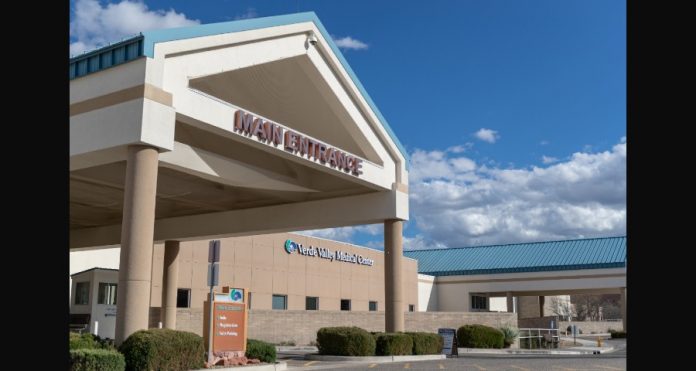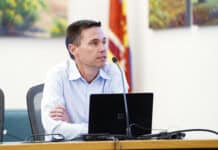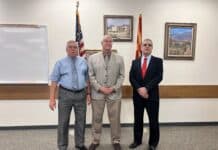
During a media briefing on Wednesday, Aug. 12, the day that Northern Arizona University began its fall term, Northern Arizona Healthcare officials said they were confident the hospital system could respond to the evolving health landscape as schools and institutions of higher learning begin tentatively reopening across Northern Arizona this month.
With Yavapai College starting the fall semester online this week and NAU commencing fall classes online last week, with plans to introduce in-person instruction on Aug. 31, some area residents are worried about the impact that an influx of students from other parts of the country could have on Northern Arizona’s COVID-19 numbers, which have been trending downward. Among the plans for the reopening, NAU students are required to be tested for COVID- 19 before moving into student housing, and all students are encouraged to be tested before returning to campus.
During the recent briefing, Northern Arizona Healthcare officials addressed concerns about school reopening and expressed confidence in their ability to respond to new outbreaks. While there’s an inherent risk in introducing new populations of people to the region, officials said, the hospital system is in a good position currently as schools put their reopening plans to the test this fall.
“We certainly have the capacity to care for patients,” Dr. John Mougin, chief quality officer for NAH, said, “and as long as our community continues to do its responsible activities with things like masking and demonstrating good physical distancing, good hygiene habits, I think we can keep our whole community healthy.”
In the briefing, Mougin said he supported school districts and colleges trying to make some form of in-person learning work this fall, assuming they are implementing protocols informed by the current science on COVID-19.
“I understand the concerns and fears of kids going back to school. But on the other hand, I also think it’s a bridge we’re going to have to cross at some point, and we’re going to have to cross it in a safe and responsible manner … so we have to figure it out, and we’re certainly looking to find ways to figure it out and do it in a safe manner, or as safe as possible,” Mougin said.
Verde Valley Rates
The rate of new COVID-19 detections in the Verde Valley has been trending downward since a July 1 peak, when 99 new cases were recorded in a one-week period.
Since then, new infections have slowly decreased. During the week ending Aug. 9, there were 63 new cases recorded in the Verde Valley.
The number of COVID hospitalizations has also been decreasing locally and across Arizona.
Ron Haase, chief administrative officer for Verde Valley Medical Center, noted in the briefing that VVMC only had two COVID-19 in-patients as of that day, down from highs of over 20 COVID in-patients in July.
VVMC slowed elective procedures during the COVID spike in July, “but we have now turned that spigot back on, and for the last at least three days, four days, our elective surgeries have been very, very busy at Verde Valley [Medical Center],” Haase said.
But while infection numbers are moving in the right direction, NAH officials in the press briefing thought it would be awhile before the state hit Arizona Gov. Doug Ducey’s recently introduced benchmark’s for allowing fully in-person instruction.
“We’re continuing to see a decline in our cases, which is a positive piece of data. However, I don’t know that we’re terribly close to meeting those benchmarks. I do think that it’s nice to have benchmarks, and that we’re using data and informed decisions to make those determinations as to whether or not it’s safe to open,” said Tyffany Laurano, NAH’s chief nursing officer.
Mougin predicted that a successful reopening of schools and businesses would depend on more than just meeting the benchmarks in infection data.
“I think an even more important question might be, ‘what’s going to happen after we reopen?’ Because we’re going to have to test those waters at some point, and hopefully we’ve learned from the past that we have to do it in a smart way,” he said.
While feeling optimistic about lessons learned and adaptations made by the health care system over the preceding months of the pandemic, NAH officials who participated in the briefing also noted that some hurdles in battling COVID-19 remain stubborn problems months after the start of the outbreak.
Rapid turnaround tests — in-house tests with results within a few hours — are still unavailable for the majority of tests due to “some challenges with the supply chain,” Mougin said.
Most of NAH’s COVID-19 tests are processed by outside labs, and while turnaround times are improving, officials said, some tests are still taking longer than three days to return results. In a press release last week, Yavapai County Community Health Services announced that Sonora Quest Laboratories, a major contractor for COVID-19 tests, had added testing production lines and hired 200 new employees in a bid to speed up test results.
But one of the original COVID-19 shortages is still an issue. Accessing adequate supplies of personal protective equipment, like N95 masks and shoe covers, still requires extra effort by the system and community partners, due to a “continued nationwide PPE shortage,” Mougin said.
But on the positive side, Mougin said, treatments for COVID-19 have been improving since the start of the outbreak.
“I think the treatment options, what we know about COVID- 19, and our ability to treat patients and get them out of the hospital and have them recover and get back to their lives, we’re in a much better place as far as that’s concerned,” he said.
Mougin said he was also pleased to see that multiple promising COVID vaccines, still “the biggest hope,” are currently in the pipeline, as well as new drugs for treating COVID-19.
But for Mougin, returning to normal life, like in-person learning, still depends very much on the low-tech modes of fighting the virus, especially the community making good choices about masks and social distancing.
“Just because we say we’re going to reopen doesn’t mean that we lose the masks and lose the precautions. If we do it and keep those other things in place, I think we’ll do better this time around,” he said.





















